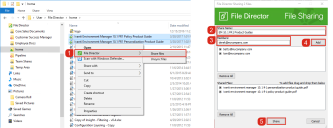File Director
This page refers to an older version of the product.View the current version of the online Help.
Windows tasks
In this section:
- Uploads and downloads
- Share files
- Clear locally cached File Director files on Windows
- Synchronize Windows files
Uploads and downloads
Upload files to your File Director server as follows:
- When logged into File Director on Windows, save files to any writable location in your File Director folder.
- Add files using the File Director Web Client.
- Using the iOS app, by move or copy files from other providers.
You cannot upload files to read-only folders.
When logged in to a desktop computer with the File Director client running, save, paste, or drag files and folders into your File Director home folder or a shared map point. From there the files are automatically synchronized with the server and available from your other File Director devices and the web client.
You cannot upload files to a read-only map point.
Depending on your organization's settings, you can also add, copy, and move files to File Director using the mobile and web clients. Whichever client you use, you can access uploaded files from the File Director folder on your desktop.
If you lose connection, log out, or shut down your endpoint while uploading or downloading files, synchronization automatically continues on re-connection to the server. For uploads, when the upload has completed, content is merged with existing content, automatically cleaning up unused data.
Depending on your folder settings, all your File Director files are automatically downloaded, or they are individually downloaded as you open them.
File Director Policy
Using File Director's policy settings, an organization can restrict who has access to File Director and what actions they can perform. For example, access can be restricted by platform, IP address, and Organizational Unit (OU).
Administrators can also apply policy settings to prevent users uploading files, printing, and copying data from mobile devices.
If you have any queries about your organization's policy settings, contact your IT Support department.
Share files
- Locate the file or files you want to share, right-click and select File Director > Share.
-
Enter a name for the share.
This is optional but it helps you and any recipients identify shares in the Web Console. If you do not enter a name, the share is automatically name Shared Files. This could lead to confusion with multiple shares having the same name. Share names cannot include the % character.
- Enter the email addresses that you want to receive a link to the files. Multiple recipients should be separated by a semicolon.
-
Click Add.
To remove a recipient, click the X next to their email address.
- Click Share.
The server sends an email to the specified address(es) containing a link to the current version of the file(s) at that time.
Clear locally cached File Director files on Windows
To remove downloaded files from a Windows desktop within the File Director folder, right-click a file or folder and select File Director > Unsync. The local copy of any selected file is removed but is visible and available to download. For folders, the contents of the selected folder and any subfolders are removed but remain visible and available for download.
The download icons are only displayed if you have Highlight downloaded files selected in your General Preferences.
If you delete files from your Home folder or a shared map point, they are removed from your server and are not available to download to your devices or desktops.
Synchronize Windows files
Right-click a folder and select File Director from the shortcut menu. You can switch between the following two options to set the required behavior for each folder:
- Unsync - You download files to your computer as you access them. If you add a file through the web client, you can see the file on your computer but it is downloaded only when you open it. When you are not logged in to File Director, you can view and access only those files that have been downloaded.
- Sync - When you are logged in to File Director, all files in your File Director folder are automatically downloaded. If you add a file through the web client, it is automatically downloaded to your computer when you are logged on to File Director. When you are not logged in to File Director, all the files that you downloaded before logging off are accessible.
You can override the folder by applying a different setting to individual files and subfolders.
For example, you apply the Sync setting to your home folder - all files and folders in your home folder automatically synchronize when you are logged in to File Director. However, there can be folders that you do not want to automatically synchronize. A folder may contain very large files that you do not access very often. If you apply the Unsync setting to that folder, any downloaded files are removed from your computer and files are only downloaded when you open them. All other files and folders in your home folder remain set to synchronize automatically.
Depending on your organization's File Director configuration, some files can be prevented from automatically synchronizing. Restrictions can be applied based on file size, type, name, age, and location. Although restricted files do not automatically synchronize, you can manually download individual files by selecting Sync file from the shortcut menu.
If you lose connection, log out, or shut down your endpoint while uploading or downloading files, synchronization automatically continues on re-connection to the server. For uploads, when the upload has completed, content is merged with existing content - automatically cleaning up unused data.
Related topics
Copyright © 2019, Ivanti. All rights reserved.

